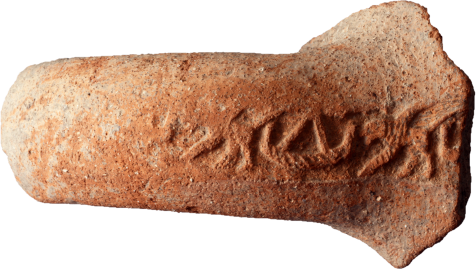Near symmetrical hull with high vertical posts ending in a pointed tip. The left post has a gentler outward incline, while the right one rises sharply upward. Mast amidships with two stays. Two rowers are represented as mushroom shaped heads, with their oars shown below.
Ship and smiting weather god
L55
c. 1770-1710 BC. Early 13th dynasty
Tell el-Dab'a, on the pavement of the Middle Kingdom (Dynasty XIII) palace, stratum G/4 (phase d/1)
L: 1.85 cm; D: 1.1 cm; Stringhole: 0.43 cm
Hematite cylinder seal, broken.
2995
Bietak 1996, 28, fig. 25; Manolova and Bretschneider 2019: 122, 140, fig. 5.1; Porada 1984, pl. 65:1; Wachsmann 1998, 42, fig. 3.1; Yasur-Landau 2017: 132-133, 135, fig. 1
The seal shows a Syrian weather god in a smithing pose holding a fenestrated axe and a mace in each hand respectively. He is coiffed with a long projecting curl and strides atop two mountains decorated with crisscross markings. In front of him is either a bird or a winged disc, while below is a ship with two rowers and a goat. Additional motifs include the weather god's emblematic animal - a bull with its head down standing atop a guilloche, as well as a seated lion, a bird and a serpent below it. This snake is possibly Yam, personification of the sea that was vanquished by Baal (Bietak 1990:15; 2010: 157). The placement and proximity of the ship vis-à-vis the weather god indicates his role as protector of seafarers, with the overall composition possibly being an invocation for good weather conditions and safe travels. The deity is probably Baal Saphon, whose palatial residence was located on Mt. Saphon (modern Jebel Aqra, Akkadian Hazzi) in the Ugaritic Baal cycle. His enduring centrality in the maritime sphere is confirmed by the 7th century treaty between the king of Tyre and Esarhaddon (680-669), where he is invoked alongside Baal-shameme and Baa-malage to act as guarantors to dispense maritime calamities upon Tyre should the treaty be broken (Yasur-Landau 2017: 132-133). Possible candidates for the mountains upon which Baal is striding are Mt. Saphon (Hazzi) and Mt. Namni (Amanus), with the former acting as a prominent landmark for mariners. The seal is thought to be carved locally but following Syrian examples, showing some non-Syrian traits but also a clear dependence on Old Syrian iconography of a god striding on top of two mountains (Porada 1984: 487-488; Bietak 2010: 157).
The ship and medium find a close parallel in a roughly contemporary seal from Sidom (L54). This is arguably the earliest extant representation of a mnš ship alongside its parallel from Sidon.
Bietak, M. 1996. Avaris, The Capital of the Hyksos, Recent Excavations at Tell el-Daba. London: British Museum Press.
Manolova, T. and J. Bretschneider. 2019. “An Unprecedented Depiction of a Syro-Canaanite Oared Galley on a Jar Sealing from Tell Tweini,” in J. Bretschneider J. and G. Jans (eds.), About Tell Tweini (Syria). Artefacts, Ecofacts and Landscape. Research Results of the Belgian Mission. Orientalia Lovaniensia Analecta 281. Peeters, pp. 117-148.
Porada, E. 1984. Corpus of Ancient Near Eastern Seals in North American Collections I. The Collection of the Pierpont Morgan Library (The Bollingen Series 14). Washington: Bollingen Foundation.
Wachsmann, S. 1998. Seagoing Ships & Seamanship in the Bronze Age Levant. College Station, TX: Texas A&M University Press.
Yasur-Landau A. 2017. “Twin Peaks: From Mt. Saphon to the Pillars of Herakles,” in B. Halpern and K.S. Sacks (eds) Cultural Contact and Appropriation in the Axial-Age Mediterranean World. Leiden: Brill, pp. 129-136.



